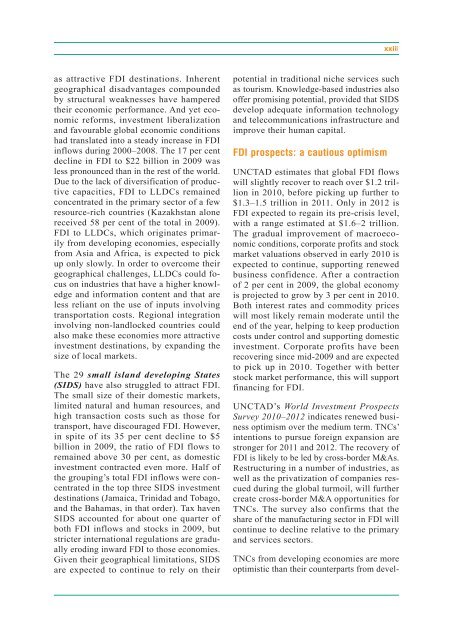UN World Investment Report 2010 - Office of Trade Negotiations
UN World Investment Report 2010 - Office of Trade Negotiations
UN World Investment Report 2010 - Office of Trade Negotiations
You also want an ePaper? Increase the reach of your titles
YUMPU automatically turns print PDFs into web optimized ePapers that Google loves.
as attractive FDI destinations. Inherent<br />
geographical disadvantages compounded<br />
by structural weaknesses have hampered<br />
their economic performance. And yet economic<br />
reforms, investment liberalization<br />
and favourable global economic conditions<br />
had translated into a steady increase in FDI<br />
inflows during 2000–2008. The 17 per cent<br />
decline in FDI to $22 billion in 2009 was<br />
less pronounced than in the rest <strong>of</strong> the world.<br />
Due to the lack <strong>of</strong> diversification <strong>of</strong> productive<br />
capacities, FDI to LLDCs remained<br />
concentrated in the primary sector <strong>of</strong> a few<br />
resource-rich countries (Kazakhstan alone<br />
received 58 per cent <strong>of</strong> the total in 2009).<br />
FDI to LLDCs, which originates primarily<br />
from developing economies, especially<br />
from Asia and Africa, is expected to pick<br />
up only slowly. In order to overcome their<br />
geographical challenges, LLDCs could focus<br />
on industries that have a higher knowledge<br />
and information content and that are<br />
less reliant on the use <strong>of</strong> inputs involving<br />
transportation costs. Regional integration<br />
involving non-landlocked countries could<br />
also make these economies more attractive<br />
investment destinations, by expanding the<br />
size <strong>of</strong> local markets.<br />
The 29 small island developing States<br />
(SIDS) have also struggled to attract FDI.<br />
The small size <strong>of</strong> their domestic markets,<br />
limited natural and human resources, and<br />
high transaction costs such as those for<br />
transport, have discouraged FDI. However,<br />
in spite <strong>of</strong> its 35 per cent decline to $5<br />
billion in 2009, the ratio <strong>of</strong> FDI flows to<br />
remained above 30 per cent, as domestic<br />
investment contracted even more. Half <strong>of</strong><br />
the grouping’s total FDI inflows were concentrated<br />
in the top three SIDS investment<br />
destinations (Jamaica, Trinidad and Tobago,<br />
and the Bahamas, in that order). Tax haven<br />
SIDS accounted for about one quarter <strong>of</strong><br />
both FDI inflows and stocks in 2009, but<br />
stricter international regulations are gradually<br />
eroding inward FDI to those economies.<br />
Given their geographical limitations, SIDS<br />
are expected to continue to rely on their<br />
xxiii<br />
potential in traditional niche services such<br />
as tourism. Knowledge-based industries also<br />
<strong>of</strong>fer promising potential, provided that SIDS<br />
develop adequate information technology<br />
and telecommunications infrastructure and<br />
improve their human capital.<br />
FDI prospects: a cautious optimism<br />
<strong>UN</strong>CTAD estimates that global FDI flows<br />
will slightly recover to reach over $1.2 trillion<br />
in <strong>2010</strong>, before picking up further to<br />
$1.3–1.5 trillion in 2011. Only in 2012 is<br />
FDI expected to regain its pre-crisis level,<br />
with a range estimated at $1.6–2 trillion.<br />
The gradual improvement <strong>of</strong> macroeconomic<br />
conditions, corporate pr<strong>of</strong>its and stock<br />
market valuations observed in early <strong>2010</strong> is<br />
expected to continue, supporting renewed<br />
business confidence. After a contraction<br />
<strong>of</strong> 2 per cent in 2009, the global economy<br />
is projected to grow by 3 per cent in <strong>2010</strong>.<br />
Both interest rates and commodity prices<br />
will most likely remain moderate until the<br />
end <strong>of</strong> the year, helping to keep production<br />
costs under control and supporting domestic<br />
investment. Corporate pr<strong>of</strong>its have been<br />
recovering since mid-2009 and are expected<br />
to pick up in <strong>2010</strong>. Together with better<br />
stock market performance, this will support<br />
financing for FDI.<br />
<strong>UN</strong>CTAD’s <strong>World</strong> <strong>Investment</strong> Prospects<br />
Survey <strong>2010</strong>–2012 indicates renewed business<br />
optimism over the medium term. TNCs’<br />
intentions to pursue foreign expansion are<br />
stronger for 2011 and 2012. The recovery <strong>of</strong><br />
FDI is likely to be led by cross-border M&As.<br />
Restructuring in a number <strong>of</strong> industries, as<br />
well as the privatization <strong>of</strong> companies rescued<br />
during the global turmoil, will further<br />
create cross-border M&A opportunities for<br />
TNCs. The survey also confirms that the<br />
share <strong>of</strong> the manufacturing sector in FDI will<br />
continue to decline relative to the primary<br />
and services sectors.<br />
TNCs from developing economies are more<br />
optimistic than their counterparts from devel-

















